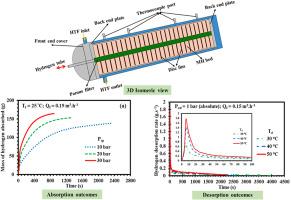用于固定式储氢的新型金属氢化物反应器的吸收和解吸行为实验研究
IF 8.1
2区 工程技术
Q1 CHEMISTRY, PHYSICAL
引用次数: 0
摘要
金属氢化物具有高能量密度和安全性,因此在氢气储存方面备受关注。然而,这些系统的性能在很大程度上受到储氢反应器设计的影响。从这个角度出发,我们设计、制造并实验测试了一种新型紧凑、轻质、高效的多管 MH 反应器。分析了新开发的 Ti0.9Zr0.1Mn1.46V0.45Fe0.09 合金在氢气存储应用中使用拟议的 MH 反应器的吸收和解吸行为。在 30 巴的供应压力下,MH 反应器在 894 秒内吸收了 164.3 克(1.58 wt.%)氢气,并以 94.7 W/kgMH 的平均速率输出比能量。此外,当解吸温度设定为 50 °C 时,反应器在 2246 秒内释放出 153.6 克(1.48 重量百分比)氢气。此外,参数研究显示,将供应压力从 10 巴提高到 20 巴和 30 巴后,储存能力分别提高了 11% 和 18.9%,而吸收时间则分别大幅缩短了 43% 和 61.5%。此外,制造的反应器实现了 0.75 % 和 20.6 kg/m3 H2 的重力和体积存储密度。此外,MH 反应器的最大氢气储存效率达到了 82.3%。最后,比较结果表明,与文献中报道的其他中大容量 MH 反应器相比,本研究中研究的 MH 反应器具有更快的氢气释放速度。本文章由计算机程序翻译,如有差异,请以英文原文为准。

Experimental study on absorption and desorption behavior of a novel metal hydride reactor for stationary hydrogen storage applications
Metal hydrides have captured significant attention for hydrogen storage because of their high energy density and safety. However, the performance of these systems is largely influenced by the design of the storage reactor. In this perspective, a novel compact, lightweight, and effective multi tube MH reactor was designed, fabricated, and experimentally tested. The absorption and desorption behavior of the newly developed Ti0.9Zr0.1Mn1.46V0.45Fe0.09 alloy using the proposed MH reactor for hydrogen storage applications was analysed. At 30 bar supply pressure, the MH reactor absorbed 164.3 g (1.58 wt.%) of hydrogen in 894 s and delivered specific energy at an average rate of 94.7 W/kgMH. Further, the reactor released 153.6 g (1.48 wt.%) of hydrogen in 2246 s, when the desorption temperature was set at 50 °C. Moreover, the parametric study revealed that by raising the supply pressure from 10 bar to 20 bar and 30 bar, the stored capacity was improved by 11 % and 18.9 %, respectively, whereas the absorption time was drastically reduced by 43 % and 61.5 %, respectively. Furthermore, the fabricated reactor achieved gravimetric and volumetric storage densities of 0.75 % and 20.6 kg/m3 of H2. Also, the MH reactor achieved a maximum hydrogen storage efficiency of 82.3 %. Finally, the comparative results indicated that the MH reactor studied in this work demonstrated a faster hydrogen release rate compared to other medium to large capacity MH reactors reported in the literature.
求助全文
通过发布文献求助,成功后即可免费获取论文全文。
去求助
来源期刊

International Journal of Hydrogen Energy
工程技术-环境科学
CiteScore
13.50
自引率
25.00%
发文量
3502
审稿时长
60 days
期刊介绍:
The objective of the International Journal of Hydrogen Energy is to facilitate the exchange of new ideas, technological advancements, and research findings in the field of Hydrogen Energy among scientists and engineers worldwide. This journal showcases original research, both analytical and experimental, covering various aspects of Hydrogen Energy. These include production, storage, transmission, utilization, enabling technologies, environmental impact, economic considerations, and global perspectives on hydrogen and its carriers such as NH3, CH4, alcohols, etc.
The utilization aspect encompasses various methods such as thermochemical (combustion), photochemical, electrochemical (fuel cells), and nuclear conversion of hydrogen, hydrogen isotopes, and hydrogen carriers into thermal, mechanical, and electrical energies. The applications of these energies can be found in transportation (including aerospace), industrial, commercial, and residential sectors.
 求助内容:
求助内容: 应助结果提醒方式:
应助结果提醒方式:


